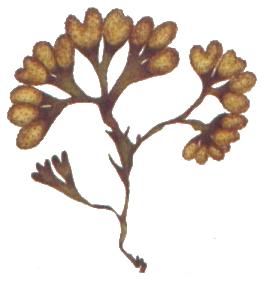Receptacle (botany) on:
[Wikipedia]
[Google]
[Amazon]
In
 In
In
botany
Botany, also called , plant biology or phytology, is the science of plant life and a branch of biology. A botanist, plant scientist or phytologist is a scientist who specialises in this field. The term "botany" comes from the Ancient Greek w ...
, the receptacle refers to vegetative tissues near the end of reproductive stems that are situated below or encase the reproductive organs.
Angiosperms
Inangiosperms
Flowering plants are plants that bear flowers and fruits, and form the clade Angiospermae (), commonly called angiosperms. The term "angiosperm" is derived from the Greek words ('container, vessel') and ('seed'), and refers to those plants th ...
, the receptacle or torus (an older term is thalamus, as in Thalamiflorae) is the thickened part of a stem (pedicel) from which the flower
A flower, sometimes known as a bloom or blossom, is the reproductive structure found in flowering plants (plants of the division Angiospermae). The biological function of a flower is to facilitate reproduction, usually by providing a mechani ...
organs grow. In some accessory fruit
An accessory fruit is a fruit in which some of the flesh is derived not from the floral ovary but from some adjacent tissue exterior to the carpel.Esau, K. 1977. ''Anatomy of seed plants''. John Wiley and Sons, New York. Accessory fruits are u ...
s, for example the pome and strawberry
The garden strawberry (or simply strawberry; ''Fragaria × ananassa'') is a widely grown hybrid species of the genus '' Fragaria'', collectively known as the strawberries, which are cultivated worldwide for their fruit. The fruit is widely ap ...
, the receptacle gives rise to the edible part of the fruit. The fruit of ''Rubus
''Rubus'' is a large and diverse genus of flowering plants in the rose family, Rosaceae, subfamily Rosoideae, with over 1,350 species.
Raspberries, blackberries, and dewberries are common, widely distributed members of the genus. Most of the ...
'' species is a cluster
may refer to:
Science and technology Astronomy
* Cluster (spacecraft), constellation of four European Space Agency spacecraft
* Asteroid cluster, a small asteroid family
* Cluster II (spacecraft), a European Space Agency mission to study t ...
of drupe
In botany, a drupe (or stone fruit) is an indehiscent fruit in which an outer fleshy part (exocarp, or skin, and mesocarp, or flesh) surrounds a single shell (the ''pit'', ''stone'', or '' pyrena'') of hardened endocarp with a seed (''kernel'') ...
lets on top of a conical receptacle. When a raspberry is picked, the receptacle separates from the fruit, but in blackberries, it remains attached to the fruit. —
In the Daisy family (Compositae or Asteraceae), small individual flowers are arranged on a round or dome-like structure that is also called receptacle.
Algae and bryophyta
 In
In phycology
Phycology () is the scientific study of algae. Also known as algology, phycology is a branch of life science.
Algae are important as primary producers in aquatic ecosystems. Most algae are eukaryotic, photosynthetic organisms that live in a ...
, receptacles occur at the ends of branches of algae
Algae (; singular alga ) is an informal term for a large and diverse group of photosynthetic eukaryotic organisms. It is a polyphyletic grouping that includes species from multiple distinct clades. Included organisms range from unicellular mic ...
mainly in the brown algae
Brown algae (singular: alga), comprising the class Phaeophyceae, are a large group of multicellular algae, including many seaweeds located in colder waters within the Northern Hemisphere. Brown algae are the major seaweeds of the temperate and p ...
or Heterokontophyta in the Order Fucales
The Fucales (fucoids) are an order in the brown algae (class Phaeophyceae). The list of families in the Fucales, as well as additional taxonomic information on algae, is publicly accessible at Algaebaseref name="Guiry and Guiry">Guiry, M.D. and ...
. They are specialised structures which contain the reproductive organs called conceptacle
Conceptacles are specialized cavities of marine and freshwater algae that contain the reproductive organs. They are situated in the receptacle and open by a small ostiole.Boney, A.D. (1969). ''A Biology of Marine Algae''. Hutchinson Educational ...
s.Fletcher, R.L. (1987). ''Seaweeds of the British Isles.'' Volume 3, Part 1. Natural History Museum
A natural history museum or museum of natural history is a scientific institution with natural history collections that include current and historical records of animals, plants, fungi, ecosystems, geology, paleontology, climatology, and more. ...
, London. Receptacles also function as a structure that captures food.
References
{{botany Plant morphology Algal anatomy